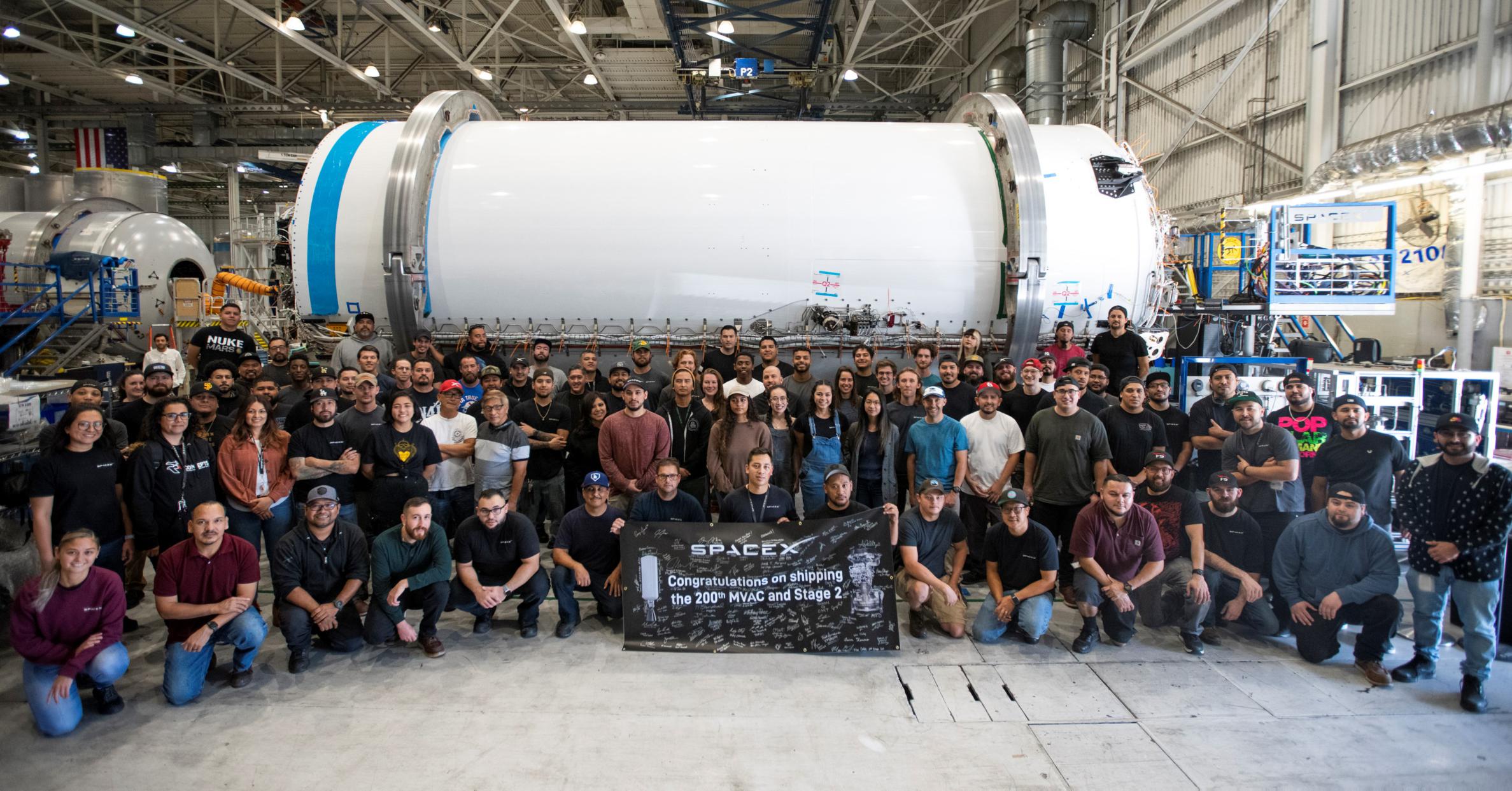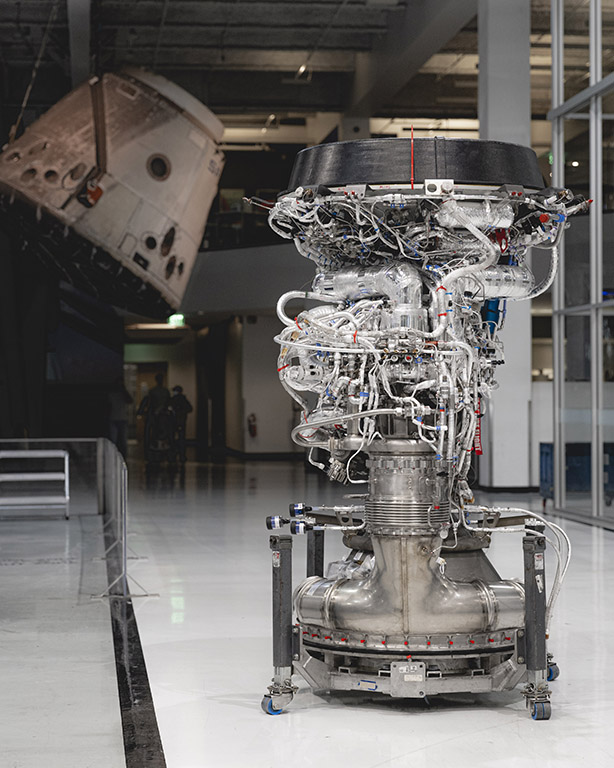

News
SpaceX ships 200th Falcon second stage, highlighting the flip-side of booster reuse
SpaceX has built and shipped its 200th Falcon second stage, highlighting the often underappreciated rocket’s record of achievement on the ground and in flight.
Approximately 13 years ago, in late 2009 or early 2010, SpaceX shipped the first flightworthy prototype of the first iteration of its Falcon 9 second stage. In June 2010, Falcon 9 lifted off on its inaugural test flight and, with the help of that second stage, successfully launched a boilerplate mockup of Dragon spacecraft into orbit. Since Falcon 9’s surprising inaugural success, SpaceX’s Falcon 9 and Falcon Heavy rockets have launched another 187 times for a total of 188 launches and 189 assembled rockets. Every one of those launches has required a new second stage, and all but one (Crew Dragon’s In-Flight Abort test) required a new Merlin Vacuum engine.
While SpaceX is most famous for the successful realization of rapidly reusable Falcon boosters, the company’s overall success is also inextricably linked to Falcon second stages, which are and always will be expended after every launch. For every spectacular Falcon booster landing or reuse record, a Falcon second stage either unceremoniously burns up in Earth’s atmosphere or finds itself stranded in orbit. As a result, even as SpaceX’s reusability has allowed it to launch more than ever before with a fleet of just 10-20 Falcon boosters, the company has had to expand the production of Falcon second stages extraordinary levels.
SpaceX just completed its 188th Falcon 9/Heavy launch, so the 200th flightworthy second stage and Merlin Vacuum (MVac) engine are probably scheduled to launch sometime in January 2023. In the last 365 days, SpaceX’s Falcon rockets have completed 59 successful orbital launches. Every launch has required a new second stage, so SpaceX, on average, has consistently built, shipped, and tested a new Falcon second stage every 6.2 days for more than a year.
Thanks to SpaceX’s record-breaking 2022 launch cadence, which has resulted in Falcon 9 launching more in one calendar year than any other rocket in history, the Falcon second stage has likely become the most-produced orbital rocket stage in decades. Barring surprises, SpaceX is on track to achieve CEO Elon Musk’s goal of 60 Falcon launches in 2022. But SpaceX isn’t done yet, and CEO Elon Musk says that the company is targeting “up to 100 launches” in 2023. After nearly doubling between early and late 2021, that will require Falcon second stage production to increase another ~67% year-over-year.
In its 12.5-year career, Falcon 9 has suffered three failures. In October 2012, on its third launch, one of Falcon 9’s nine Merlin 1C booster engines failed in flight. The main mission – a Dragon cargo mission to the International Space Station – was saved by the second stage, which autonomously compensated for the lost performance, but a secondary payload (Orbcomm’s first OG2 satellite prototype) was lost as a result. In June 2015, a faulty strut inside Falcon 9’s second stage caused a helium pressure vessel to break loose and rupture, destroying the rocket mid-flight. And in September 2016, during a prelaunch static fire test, a similar pressure vessel inside an upgraded Falcon 9’s second stage spontaneously sparked, causing an explosion that destroyed the rocket while it was still on the ground.
As a result, while problems with Falcon second stages have technically caused both of Falcon 9’s only catastrophic failures, it’s still true that a free-flying Falcon second stage has never failed in flight. The same is true for the second stage’s Merlin Vacuum engine: over hundreds of burns and more than 70,000 seconds of operation, MVac has never failed in flight.

After Falcon 9’s successful November 3rd, 2022 launch of the Eutelsat Hotbird 13G communications satellite, SpaceX’s Falcon rocket family has completed 160 launches without failure, arguably making it the most reliable rocket family in history. To achieve that feat with its partially-reusable Falcon 9 and Falcon Heavy rockets, SpaceX has had to master reusable and expendable orbital rockets to a degree that only a few other companies or space agencies in history can claim to have matched or exceeded, and that none have achieved simultaneously.

Elon Musk
Elon Musk and Tesla AI Director share insights after empty driver seat Robotaxi rides
The executives’ unoccupied tests hint at the rapid progress of Tesla’s unsupervised Robotaxi efforts.

Tesla CEO Elon Musk and AI Director Ashok Elluswamy celebrated Christmas Eve by sharing personal experiences with Robotaxi vehicles that had no safety monitor or occupant in the driver’s seat. Musk described the system’s “perfect driving” around Austin, while Elluswamy posted video from the back seat, calling it “an amazing experience.”
The executives’ unoccupied tests hint at the rapid progress of Tesla’s unsupervised Robotaxi efforts.
Elon and Ashok’s firsthand Robotaxi insights
Prior to Musk and the Tesla AI Director’s posts, sightings of unmanned Teslas navigating public roads were widely shared on social media. One such vehicle was spotted in Austin, Texas, which Elon Musk acknowleged by stating that “Testing is underway with no occupants in the car.”
Based on his Christmas Eve post, Musk seemed to have tested an unmanned Tesla himself. “A Tesla with no safety monitor in the car and me sitting in the passenger seat took me all around Austin on Sunday with perfect driving,” Musk wrote in his post.
Elluswamy responded with a 2-minute video showing himself in the rear of an unmanned Tesla. The video featured the vehicle’s empty front seats, as well as its smooth handling through real-world traffic. He captioned his video with the words, “It’s an amazing experience!”
Towards Unsupervised operations
During an xAI Hackathon earlier this month, Elon Musk mentioned that Tesla owed be removing Safety Monitors from its Robotaxis in Austin in just three weeks. “Unsupervised is pretty much solved at this point. So there will be Tesla Robotaxis operating in Austin with no one in them. Not even anyone in the passenger seat in about three weeks,” he said. Musk echoed similar estimates at the 2025 Annual Shareholder Meeting and the Q3 2025 earnings call.
Considering the insights that were posted Musk and Elluswamy, it does appear that Tesla is working hard towards operating its Robotaxis with no safety monitors. This is quite impressive considering that the service was launched just earlier this year.
Elon Musk
Starlink passes 9 million active customers just weeks after hitting 8 million
The milestone highlights the accelerating growth of Starlink, which has now been adding over 20,000 new users per day.

SpaceX’s Starlink satellite internet service has continued its rapid global expansion, surpassing 9 million active customers just weeks after crossing the 8 million mark.
The milestone highlights the accelerating growth of Starlink, which has now been adding over 20,000 new users per day.
9 million customers
In a post on X, SpaceX stated that Starlink now serves over 9 million active users across 155 countries, territories, and markets. The company reached 8 million customers in early November, meaning it added roughly 1 million subscribers in under seven weeks, or about 21,275 new users on average per day.
“Starlink is connecting more than 9M active customers with high-speed internet across 155 countries, territories, and many other markets,” Starlink wrote in a post on its official X account. SpaceX President Gwynne Shotwell also celebrated the milestone on X. “A huge thank you to all of our customers and congrats to the Starlink team for such an incredible product,” she wrote.
That growth rate reflects both rising demand for broadband in underserved regions and Starlink’s expanding satellite constellation, which now includes more than 9,000 low-Earth-orbit satellites designed to deliver high-speed, low-latency internet worldwide.
Starlink’s momentum
Starlink’s momentum has been building up. SpaceX reported 4.6 million Starlink customers in December 2024, followed by 7 million by August 2025, and 8 million customers in November. Independent data also suggests Starlink usage is rising sharply, with Cloudflare reporting that global web traffic from Starlink users more than doubled in 2025, as noted in an Insider report.
Starlink’s momentum is increasingly tied to SpaceX’s broader financial outlook. Elon Musk has said the satellite network is “by far” the company’s largest revenue driver, and reports suggest SpaceX may be positioning itself for an initial public offering as soon as next year, with valuations estimated as high as $1.5 trillion. Musk has also suggested in the past that Starlink could have its own IPO in the future.
News
NVIDIA Director of Robotics: Tesla FSD v14 is the first AI to pass the “Physical Turing Test”
After testing FSD v14, Fan stated that his experience with FSD felt magical at first, but it soon started to feel like a routine.

NVIDIA Director of Robotics Jim Fan has praised Tesla’s Full Self-Driving (Supervised) v14 as the first AI to pass what he described as a “Physical Turing Test.”
After testing FSD v14, Fan stated that his experience with FSD felt magical at first, but it soon started to feel like a routine. And just like smartphones today, removing it now would “actively hurt.”
Jim Fan’s hands-on FSD v14 impressions
Fan, a leading researcher in embodied AI who is currently solving Physical AI at NVIDIA and spearheading the company’s Project GR00T initiative, noted that he actually was late to the Tesla game. He was, however, one of the first to try out FSD v14.
“I was very late to own a Tesla but among the earliest to try out FSD v14. It’s perhaps the first time I experience an AI that passes the Physical Turing Test: after a long day at work, you press a button, lay back, and couldn’t tell if a neural net or a human drove you home,” Fan wrote in a post on X.
Fan added: “Despite knowing exactly how robot learning works, I still find it magical watching the steering wheel turn by itself. First it feels surreal, next it becomes routine. Then, like the smartphone, taking it away actively hurts. This is how humanity gets rewired and glued to god-like technologies.”
The Physical Turing Test
The original Turing Test was conceived by Alan Turing in 1950, and it was aimed at determining if a machine could exhibit behavior that is equivalent to or indistinguishable from a human. By focusing on text-based conversations, the original Turing Test set a high bar for natural language processing and machine learning.
This test has been passed by today’s large language models. However, the capability to converse in a humanlike manner is a completely different challenge from performing real-world problem-solving or physical interactions. Thus, Fan introduced the Physical Turing Test, which challenges AI systems to demonstrate intelligence through physical actions.
Based on Fan’s comments, Tesla has demonstrated these intelligent physical actions with FSD v14. Elon Musk agreed with the NVIDIA executive, stating in a post on X that with FSD v14, “you can sense the sentience maturing.” Musk also praised Tesla AI, calling it the best “real-world AI” today.








